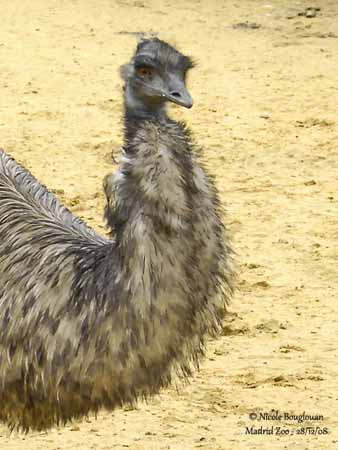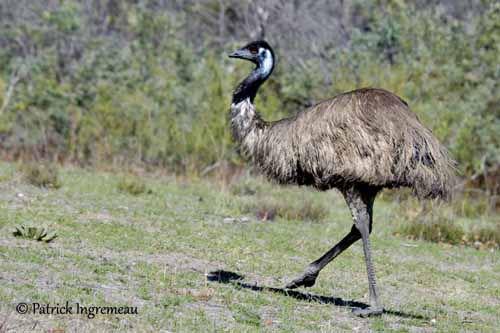
Fr: Emeu d’Australie
All : Emu
Esp : Emú
Ital : Emù
Nd: Emoe
Sd: Emu
Photographers:
Patrick Ingremeau
TAMANDUA
Nicole Bouglouan
PHOTOGRAPHIC RAMBLE
Text by Nicole Bouglouan
Sources:
HANDBOOK OF THE BIRDS OF THE WORLD vol 1 by Josep del Hoyo-Andrew Elliot-Jordi Sargatal - Lynx Edicions - ISBN: 8487334105
L’ENCYCLOPEDIE MONDIALE DES OISEAUX - Dr Christopher M. Perrins - BORDAS - ISBN: 2040185607
BIRDS OF ASIA AND AUSTRALIA by David Alderton – Southwater - ISBN : 184215978X
BirdLife International (BirdLife International)
Animal Diversity Web (University of Michigan Museum of Zoology)
Birds in backyards (Birds Australia and Australian Museum)
Emu
Dromaius novaehollandiae
Casuariiformes Order – Casuariidae Family
BIOMETRICS:
Length: 150-190 cm
Weight: 30-55 kg
DESCRIPTION:
The Emu is a flightless bird, but the long, powerful legs make it well adapted for walking and running over wide areas. This is the second largest living bird, after the Ostrich.
The adult has soft, shaggy, brown to greyish-brown plumage overall. We can see a conspicuous dorsal parting. The feathers have black tips.
This bird, as the Southern Cassowary, has loose double-feathers. There are two shafts with their barbs coming from the same base. It has small wings of about 20 cm long.
The long neck is partially feathered, but the upper neck shows pale blue bare skin reaching the ear-coverts’ area.
Head, chin, throat and cheeks are feathered black. The pale blue skin may form a supercilium joining the ear-coverts’ area. The hind neck is black too.
The bill is black. The eyes are deep red. The long, powerful legs are greyish-brown. The feet have three strong toes. Legs and feet are covered with thick skin.

The female is heavier and appears darker than male. She has brighter blue facial skin and black foreneck.
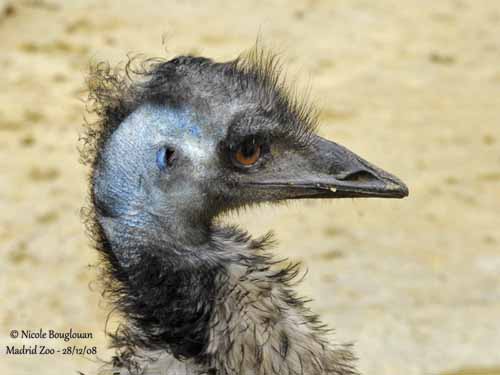
The chicks are creamy-white with dark brown stripes above. Then, this pattern fades and dull brown feathers replace the downy plumage. They need one year to be fully grown.
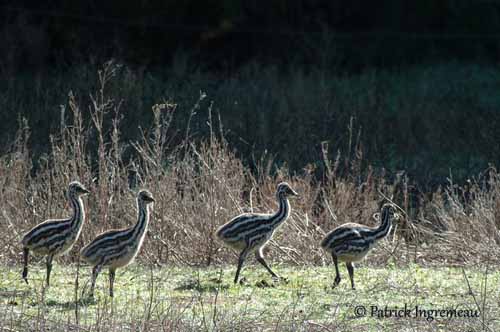
VOICE: SOUNDS BY XENO-CANTO
The Emu is usually silent, but during the breeding season or confrontations, both sexes produce grunting and booming sounds.
The grunting sounds are used by males as threat and in territorial defence, and during the courtship displays.
The females produce mainly booming sounds in similar situations. These sounds can be heard up to 2 km away. They are created in the inflatable neck sacs.
The most typical Emu’s call is a single, resonant boom or “drumming”, described as “e-moo, e-moo”, only given by females, probably to attract other males, and especially while their mate starts to incubate.
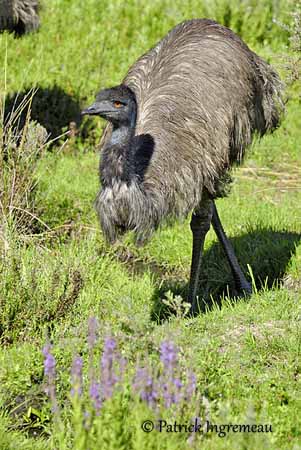
HABITAT:
The Emu frequents several types of habitats such as woodland and scrub to open country. It can be found both on coastal and inland regions, and at any elevation. They breed in grassland, heath or woodland.
This species usually avoids the rainforest and the very dry areas.
RANGE:
The Emu is found in Australia, but apart from desert areas and some south-western regions. This species has been introduced to Kangaroo Island and Maria Island, off S Australia.
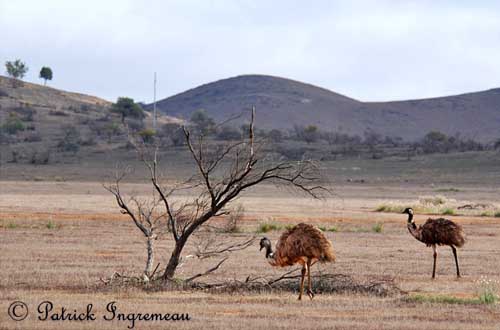
BEHAVIOUR:
The Emu is omnivorous, feeding on wide variety of food items such as seeds, fruits, shoots, grass, large insects and caterpillars.
They forage almost all the day. The vegetal food is plucked off living plants, or picked off the ground. They drink in mid-morning or midday, walking slowly towards the drinking places. But in summer, they return to the drinking areas in late afternoon.
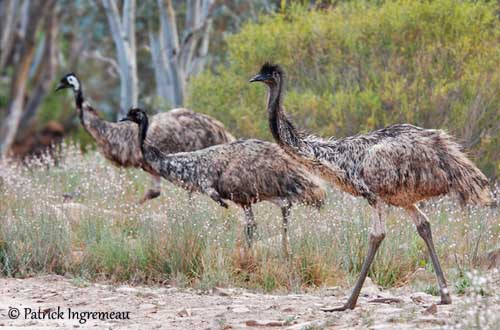
The Emu is a terrestrial species. Its long legs and powerful feet allow it to walk with little effort. It can reach a speed of about 7km/hour. A single stride covers more than 2, 70 metres. This flightless bird can run fast to escape danger, up to 48km/hour over short distances.
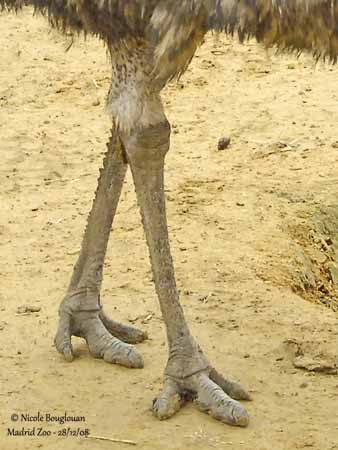
When temperatures are very hot, the Emu raises the short wings up, in order to bare the surface veins of this area, and allowing heat loss thanks to evaporation.
They sleep on the ground, although during the cold winters, they sleep in the shelter of the vegetation. They have a roost-site in each feeding area.
When resting, they lie down in the open. Their plumage blends in with the dry grass.
The Emus are usually seen alone or in pairs, or sometimes in groups of about ten birds. They are gregarious when moving and when the food resources are abundant. But usually, there is little social interaction.
If necessary, the dominant male gives a single grunt with the neck stretched forwards and the bill pointed downwards. It also may peck or chase rivals or intruders.
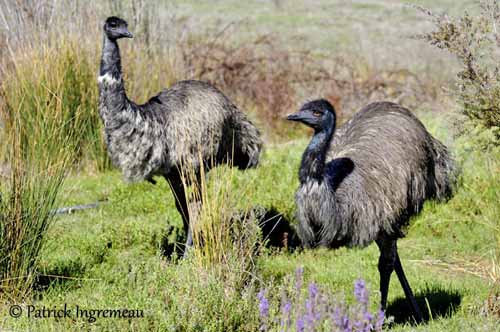
Similar behaviour is used during the courtship displays and before the laying. Another threat display is performed by both adults, but mainly by female in front of a strange situation or object. They produce repeated “boom” calls with arched neck and cervical air-sacs inflated while they circle round the object.
Emus can be aggressive during the breeding season and may even follow humans.
Emus are sedentary but nomadic, according to the food and water resources. Seasonal N-S movements occur in W Australia, following the rains.
MOVEMENTS:
The Emu is flightless, but it walks easily and can run very fast.
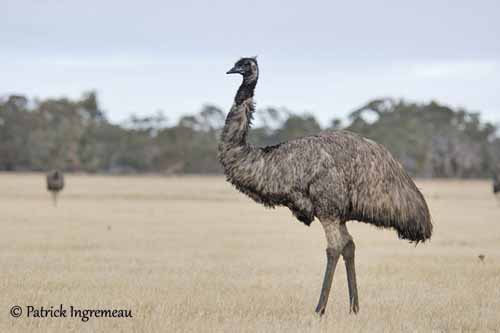
REPRODUCTION:
The breeding season starts in December-January with egg-laying in April-May.
The reproduction of the Emu is based on successive polyandry of the females, while their mates perform all the nesting duties.
After pairing in December-January, the male builds the nest, a shallow depression on the ground made with twigs, leaves and grass, in the shelter of some vegetation but with a good view of the surrounding area.
The female lays 5-15 dark green eggs, 2-4 days apart. Each egg weights between 450 and 650 grams. The male incubates during about 8 weeks, during which it does not eat, drink or defecate. For this reason, prior to start incubation, it makes considerable reserves of fat. During the incubation, it goes into a kind of torpor in order to reduce the water loss during this period. But it turns the eggs several times each day, remains close or on the nest and preens.
During this period, the female is rejected to avoid more eggs.
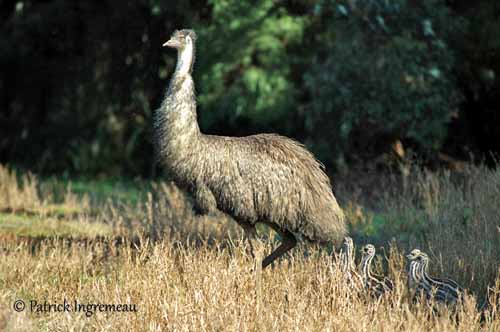
At hatching, the chicks are precocial and able to walk within 24 hours. Their cryptic striped down protect them. They leave the nest within the first week, between 2 and 7 days after hatching, and they can run and swim very soon.
The male accompanies and looks after the young during five months, but sometimes up to 18 months. It is very aggressive against its mate and all intruders and predators such as birds of prey, foxes and dingos. The young are sexually mature at 2-3 years old.
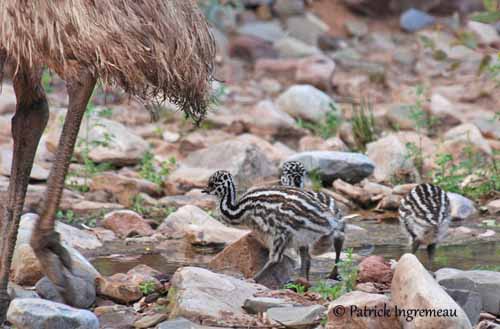
DIET:
The Emu is omnivorous, but it feeds regularly on highly nutritious food. It feeds on seeds, fruits, flowers and tender roots. In summer, large quantities of insects are eaten, especially caterpillars, grasshoppers and beetles. It also takes small vertebrates.
Coprophagy is also recorded in order to avoid deshydratation in dry areas where food resources are scarce. In suitable habitat, it drinks 2-3 times a day.
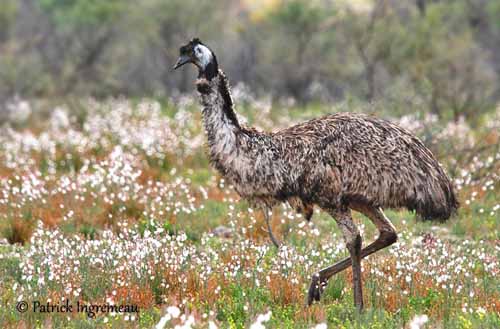
PROTECTION / THREATS / STATUS:
The Emu has stable populations. This species has benefited from human alterations to the environment, such as water supplies and fences which protect them from predators.
The Emu is not currently threatened.
